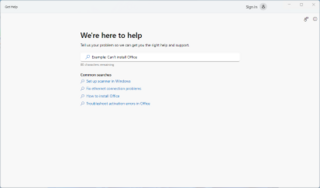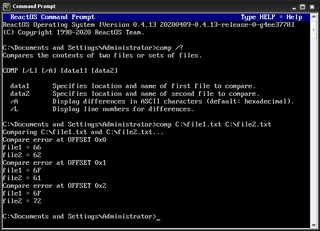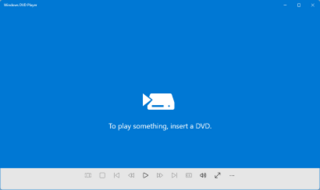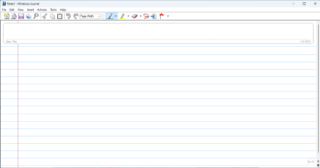 W
WGet Help, known as Contact Support before the Windows 10 Creators Update, is a built-in interface for communicating with Microsoft customer service employees over the Internet. The opening screen requests that the user specify a product and explain a problem with it. It also offers the user links to online help articles for business and IT support, Microsoft Store sales and support, and a disability answer desk.
 W
WApp Installer is a software component of Windows 10, introduced in the 2016 Anniversary Update, used for the installation and maintenance of applications packaged in .appx or .appxbundle installation packages; they are loosely relational databases with an XML app manifest. The .appx and .appxbundle files contain either a Win32 or a Universal Windows Platform app, icons for the Start menu and taskbar, a virtualized version of any Windows Registry keys needed, and any other assets needed for the installed app to function.
 W
WIn computing, comp is a command used on DEC OS/8, DOS, DR FlexOS, IBM OS/2, Microsoft Windows and related computer operating systems such as ReactOS. It is used to perform comparisons of multiple computer files to show the differences between them.
 W
WThe Desktop Cleanup Wizard is a component included with Microsoft's Windows XP operating system. It aims to reduce the clutter in a user's desktop environment by moving unused shortcuts to a separate directory called "Unused Desktop Shortcuts". When run it shows a list of shortcuts, and the user can select which shortcuts to move to the "Unused Desktop Shortcuts" directory.
 W
WDr. Watson is an application debugger included with the Microsoft Windows operating system. It may be named drwatson.exe, drwtsn32.exe or dwwin.exe, depending on the version of Windows.
 W
WDVD Player is an app developed by Microsoft that plays DVD-Video on Microsoft Windows. DVD Player was introduced in Windows 98, and was included in Windows ME and Windows 2000 before removal from Windows XP and beyond. After Windows XP, DVD playback was built into other apps such as Windows Media Player and Windows Media Center instead. Following the discontinuation of Media Center in Windows 10 and the removal of DVD codecs from Windows 8, DVD Player was reintroduced to Windows 10 as an app available from Microsoft Store.
 W
WIObit Uninstaller is an application for Microsoft's Windows developed by IObit Inc. The software is an uninstall utility, which extends the method of uninstalling in Windows OS. It removes programs, toolbar and some leftover registry entries or browser plugins.
 W
W3D Viewer is a 3D object viewer and Augmented Reality application that was first included in Windows 10 1703. It supports the .fbx, .3mf, .obj, and .stl and many more file formats listed in features section.
 W
WIn computing, move is a command in various command-line interpreters (shells) such as COMMAND.COM, cmd.exe, 4DOS/4NT, and PowerShell. It is used to move one or more files or directories from one place to another. The original file is deleted, and the new file may have the same or a different name. The command is analogous to the Unix mv command and to the OpenVOS move_file and move_dircommands.
 W
WPerformance Monitor is a system monitoring program introduced in Windows NT 3.1. It monitors various activities on a computer such as CPU or memory usage. This type of application may be used to determine the cause of problems on a local or remote computer by measuring the performance of hardware, software services, and applications.
 W
WIn computing, replace is a command that is used to replace one or more existing computer files or add new files to a target directory. Files with a hidden or system attribute set cannot be replaced using replace. The command lists all files that are replaced.
 W
WSettings or Windows Settings is a component of Microsoft Windows which was introduced in Windows 8. It allows the user to customize and configure the operating system. Microsoft intends it to eventually replace the existing Control Panel. It provides access to the main configuration options and settings for a user's PC. While very similar to the original Control Panel, the new Settings menu features categories of possible user interactions and activities, rather than simply listing all devices and options, from whom a user is supposed to choose.
 W
WIn computing, tree is a recursive directory listing command or program that produces a depth-indented listing of files. Originating in PC- and MS-DOS, it is found in Digital Research FlexOS, IBM/Toshiba 4690 OS, PTS-DOS, FreeDOS, IBM OS/2, Microsoft Windows, and ReactOS. A version for Unix and Unix-like systems is also available.
 W
WUnified Hangul Code (UHC), or Extended Wansung, also known under Microsoft Windows as Code Page 949, is the Microsoft Windows code page for the Korean language. It is an extension of Wansung Code to include all 11172 Hangul syllables present in Johab. This corresponds to the pre-composed syllables available in Unicode 2.0 and later.
 W
WWindows Embedded Compact 7 is the seventh major release of the Windows Embedded CE operating system, released on March 1, 2011. Windows Embedded Compact 7 is a real-time OS, separate from the Windows NT line, and is designed to target enterprise specific tools such as industrial controllers and consumer electronics devices such as digital cameras, GPS systems and also automotive infotainment systems. Windows Embedded Compact is designed to run on multiple CPU architectures and supports x86, SH and ARM.
 W
WWindows for Pen Computing is a software suite for Windows 3.1x, that Microsoft designed to incorporate pen computing capabilities into the Windows operating environment. Windows for Pen Computing was the second major pen computing platform for x86 tablet PCs; GO Corporation released their operating system, PenPoint OS, shortly before Microsoft published Windows for Pen Computing 1.0 in 1992.
 W
WThe Windows Installer CleanUp Utility was a software utility for the Microsoft Windows operating system designed to solve uninstallation problems of programs that use the Windows Installer technology. It looks up registry references and files related to Windows Installer that were installed by various programs, and forcibly wipes invalid entries out. It works in all 32-bit and 64-bit versions of Microsoft Windows.
 W
WWindows Journal is a discontinued notetaking application, created by Microsoft and included in Windows XP Tablet PC Edition as well as select editions of Windows Vista and later. It allowed the user to create and organize handwritten notes and drawings, and to save them in a .JNT file, or export them in TIFF format. It can use an ordinary computer mouse to compose a handwritten note, as well as a graphics tablet or a Tablet PC.
 W
WWindows Terminal is a multi-tabbed command-line front-end that Microsoft has developed for Windows 10, as a replacement for Windows Console. It can run any command-line app, including all Windows terminal emulators, in a separate tab. It is preconfigured to run Command Prompt, PowerShell, WSL, SSH, and Azure Cloud Shell Connector.